| MeSH term | MeSH ID | Detail |
|---|---|---|
| Radiation Injuries, Experimental | D011833 | 11 associated lipids |
| Tachycardia, Ectopic Atrial | D013612 | 1 associated lipids |
| Wounds, Gunshot | D014948 | 2 associated lipids |
| Reperfusion Injury | D015427 | 65 associated lipids |
| Tachycardia, Ventricular | D017180 | 9 associated lipids |
| Ventricular Dysfunction, Left | D018487 | 33 associated lipids |
n-heptanol
N-heptanol is a lipid of Fatty Acyls (FA) class. N-heptanol is associated with abnormalities such as Corneal Neovascularization. N-heptanol often locates in Epithelium and Structure of corneal epithelium. The related lipids are Heptanol.
Cross Reference
Introduction
To understand associated biological information of n-heptanol, we collected biological information of abnormalities, associated pathways, cellular/molecular locations, biological functions, related genes/proteins, lipids and common seen animal/experimental models with organized paragraphs from literatures.
What diseases are associated with n-heptanol?
n-heptanol is suspected in Corneal Neovascularization and other diseases in descending order of the highest number of associated sentences.
Related references are mostly published in these journals:
| Disease | Cross reference | Weighted score | Related literature |
|---|
Possible diseases from mapped MeSH terms on references
We collected disease MeSH terms mapped to the references associated with n-heptanol
PubChem Associated disorders and diseases
What pathways are associated with n-heptanol
There are no associated biomedical information in the current reference collection.
PubChem Biomolecular Interactions and Pathways
Link to PubChem Biomolecular Interactions and PathwaysWhat cellular locations are associated with n-heptanol?
Visualization in cellular structure
Associated locations are in red color. Not associated locations are in black.
Related references are published most in these journals:
| Location | Cross reference | Weighted score | Related literatures |
|---|
What functions are associated with n-heptanol?
There are no associated biomedical information in the current reference collection.
What lipids are associated with n-heptanol?
Related references are published most in these journals:
| Lipid concept | Cross reference | Weighted score | Related literatures |
|---|
What genes are associated with n-heptanol?
There are no associated biomedical information in the current reference collection.
What common seen animal models are associated with n-heptanol?
There are no associated biomedical information in the current reference collection.
NCBI Entrez Crosslinks
All references with n-heptanol
Download all related citations| Authors | Title | Published | Journal | PubMed Link |
|---|---|---|---|---|
| Ye JH et al. | Functional connectivity map of retinal ganglion cells for retinal prosthesis. | 2008 | Korean J. Physiol. Pharmacol. | pmid:19967072 |
| Biktashev VN et al. | Generation and escape of local waves from the boundary of uncoupled cardiac tissue. | 2008 | Biophys. J. | pmid:18212013 |
| Hong T et al. | Inhibitory effect of gap junction blockers on cerebral vasospasm. | 2008 | J. Neurosurg. | pmid:18312103 |
| Kurebayashi N et al. | Aberrant cell-to-cell coupling in Ca2+-overloaded guinea pig ventricular muscles. | 2008 | Am. J. Physiol., Cell Physiol. | pmid:18385286 |
| Tsai JA et al. | Albumin-bound lipids induce free cytoplasmic calcium oscillations in human osteoblast-like cells. | 2007 May-Jun | Cell Biochem. Funct. | pmid:16397911 |
| Sosne G et al. | Thymosin beta 4: A novel corneal wound healing and anti-inflammatory agent. | 2007 | Clin Ophthalmol | pmid:19668473 |
| Kasi VS et al. | Cardiac-restricted angiotensin-converting enzyme overexpression causes conduction defects and connexin dysregulation. | 2007 | Am. J. Physiol. Heart Circ. Physiol. | pmid:17337599 |
| Syme NR et al. | Origin of heat capacity changes in a "nonclassical" hydrophobic interaction. | 2007 | Chembiochem | pmid:17625803 |
| Liu N et al. | Integrated olfactory receptor and microarray gene expression databases. | 2007 | BMC Bioinformatics | pmid:17603910 |
| Miura T et al. | Delta-opioid receptor activation before ischemia reduces gap junction permeability in ischemic myocardium by PKC-epsilon-mediated phosphorylation of connexin 43. | 2007 | Am. J. Physiol. Heart Circ. Physiol. | pmid:17513490 |
